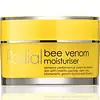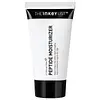What's inside
What's inside
 Key Ingredients
Key Ingredients

 Benefits
Benefits

 Concerns
Concerns

 Ingredients Side-by-side
Ingredients Side-by-side

Water
Skin ConditioningCyclopentasiloxane
EmollientButyrospermum Parkii Butter
Skin ConditioningGlycerin
HumectantOryza Sativa Germ Oil
EmollientDimethicone
EmollientEthylhexanol
PerfumingSqualane
EmollientCaprylic/Capric Triglyceride
MaskingCetyl Alcohol
EmollientCyclohexasiloxane
EmollientPolysilicone-11
Cetearyl Alcohol
EmollientGlyceryl Dibehenate
EmollientPhenoxyethanol
PreservativeGlyceryl Stearate
EmollientPEG-75 Stearate
Tribehenin
EmollientAlcohol
AntimicrobialAscorbyl Tetraisopalmitate
AntioxidantCeteth-20
CleansingSteareth-20
CleansingGlyceryl Behenate
EmollientEctoin
Skin ConditioningLecithin
EmollientPolyacrylamide
Xanthan Gum
EmulsifyingOcimum Basilicum Meristem Cell Culture
Skin ConditioningParfum
MaskingEthylhexylglycerin
Skin ConditioningSodium Hyaluronate
HumectantTocopherol
AntioxidantC13-14 Isoparaffin
EmollientDisodium EDTA
Geranylgeranylisopropanol
Skin ConditioningHelianthus Annuus Seed Oil
EmollientLaureth-7
EmulsifyingTriethanolamine
BufferingCitric Acid
BufferingAlpha-Isomethyl Ionone
PerfumingHydroxycitronellal
PerfumingLimonene
PerfumingCitronellol
PerfumingSodium Benzoate
MaskingPotassium Sorbate
PreservativeBeta-Carotene
Skin ConditioningDaucus Carota Sativa Root Extract
Skin ConditioningDaucus Carota Sativa Seed Oil
EmollientCyclotetrapeptide-24 Aminocyclohexane Carboxylate
AntioxidantAscorbyl Palmitate
AntioxidantBee Venom
AstringentWater, Cyclopentasiloxane, Butyrospermum Parkii Butter, Glycerin, Oryza Sativa Germ Oil, Dimethicone, Ethylhexanol, Squalane, Caprylic/Capric Triglyceride, Cetyl Alcohol, Cyclohexasiloxane, Polysilicone-11, Cetearyl Alcohol, Glyceryl Dibehenate, Phenoxyethanol, Glyceryl Stearate, PEG-75 Stearate, Tribehenin, Alcohol, Ascorbyl Tetraisopalmitate, Ceteth-20, Steareth-20, Glyceryl Behenate, Ectoin, Lecithin, Polyacrylamide, Xanthan Gum, Ocimum Basilicum Meristem Cell Culture, Parfum, Ethylhexylglycerin, Sodium Hyaluronate, Tocopherol, C13-14 Isoparaffin, Disodium EDTA, Geranylgeranylisopropanol, Helianthus Annuus Seed Oil, Laureth-7, Triethanolamine, Citric Acid, Alpha-Isomethyl Ionone, Hydroxycitronellal, Limonene, Citronellol, Sodium Benzoate, Potassium Sorbate, Beta-Carotene, Daucus Carota Sativa Root Extract, Daucus Carota Sativa Seed Oil, Cyclotetrapeptide-24 Aminocyclohexane Carboxylate, Ascorbyl Palmitate, Bee Venom
Water
Skin ConditioningCaprylic/Capric Triglyceride
MaskingGlycerin
HumectantC12-15 Alkyl Benzoate
AntimicrobialCetearyl Alcohol
EmollientGlyceryl Stearate Se
EmulsifyingBetaine
HumectantButylene Glycol
HumectantPhenoxyethanol
PreservativeBenzyl Alcohol
PerfumingCarbomer
Emulsion StabilisingButyrospermum Parkii Butter
Skin ConditioningSodium Stearoyl Glutamate
CleansingSodium Hydroxide
BufferingEthylhexylglycerin
Skin ConditioningSodium Gluconate
Skin ConditioningTocopheryl Acetate
AntioxidantDehydroacetic Acid
PreservativeHydrogenated Lecithin
EmulsifyingPhenethyl Alcohol
MaskingAcetyl Hexapeptide-37
Skin ConditioningMaltodextrin
AbsorbentPentapeptide-48
Skin ConditioningWater, Caprylic/Capric Triglyceride, Glycerin, C12-15 Alkyl Benzoate, Cetearyl Alcohol, Glyceryl Stearate Se, Betaine, Butylene Glycol, Phenoxyethanol, Benzyl Alcohol, Carbomer, Butyrospermum Parkii Butter, Sodium Stearoyl Glutamate, Sodium Hydroxide, Ethylhexylglycerin, Sodium Gluconate, Tocopheryl Acetate, Dehydroacetic Acid, Hydrogenated Lecithin, Phenethyl Alcohol, Acetyl Hexapeptide-37, Maltodextrin, Pentapeptide-48
 Reviews
Reviews

Ingredients Explained
These ingredients are found in both products.
Ingredients higher up in an ingredient list are typically present in a larger amount.
This ingredient is also known as shea butter. It is an effective skin hydrator and emollient.
Emollients help soothe and soften your skin. It does this by creating a protective film on your skin. This barrier helps trap moisture and keeps your skin hydrated. Emollients may be effective at treating dry or itchy skin.
Shea butter is rich in antioxidants. Antioxidants help fight free-radicals, or molecules that may harm the body. It is also full of fatty acids including stearic acid and linoleic acid. These acids help replenish the skin and keep skin moisturized.
While Shea Butter has an SPF rating of about 3-4, it is not a sunscreen replacement.
Shea butter may not be fungal acne safe. We recommend speaking with a professional if you have any concerns.
Learn more about Butyrospermum Parkii ButterThis ingredient is an emollient, solvent, and texture enhancer. It is considered a skin-softener by helping the skin prevent moisture loss.
It helps thicken a product's formula and makes it easier to spread by dissolving clumping compounds.
Caprylic Triglyceride is made by combining glycerin with coconut oil, forming a clear liquid.
While there is an assumption Caprylic Triglyceride can clog pores due to it being derived from coconut oil, there is no research supporting this.
Learn more about Caprylic/Capric TriglycerideCetearyl alcohol is a mixture of two fatty alcohols: cetyl alcohol and stearyl alcohol. It is mainly used as an emulsifier. Emulsifiers help prevent the separation of oils and products. Due to its composition, it can also be used to thicken a product or help create foam.
Cetearyl alcohol is an emollient. Emollients help soothe and hydrate the skin by trapping moisture.
Studies show Cetearyl alcohol is non-toxic and non-irritating. The FDA allows products labeled "alcohol-free" to have fatty alcohols.
This ingredient is usually derived from plant oils such as palm, vegetable, or coconut oils. There is debate on whether this ingredient will cause acne.
Due to the fatty acid base, this ingredient may not be Malassezia folliculitis safe.
Learn more about Cetearyl AlcoholEthylhexylglycerin (we can't pronounce this either) is commonly used as a preservative and skin softener. It is derived from glyceryl.
You might see Ethylhexylglycerin often paired with other preservatives such as phenoxyethanol. Ethylhexylglycerin has been found to increase the effectiveness of these other preservatives.
Glycerin is already naturally found in your skin. It helps moisturize and protect your skin.
A study from 2016 found glycerin to be more effective as a humectant than AHAs and hyaluronic acid.
As a humectant, it helps the skin stay hydrated by pulling moisture to your skin. The low molecular weight of glycerin allows it to pull moisture into the deeper layers of your skin.
Hydrated skin improves your skin barrier; Your skin barrier helps protect against irritants and bacteria.
Glycerin has also been found to have antimicrobial and antiviral properties. Due to these properties, glycerin is often used in wound and burn treatments.
In cosmetics, glycerin is usually derived from plants such as soybean or palm. However, it can also be sourced from animals, such as tallow or animal fat.
This ingredient is organic, colorless, odorless, and non-toxic.
Glycerin is the name for this ingredient in American English. British English uses Glycerol/Glycerine.
Learn more about GlycerinPhenoxyethanol is a preservative that has germicide, antimicrobial, and aromatic properties. Studies show that phenoxyethanol can prevent microbial growth. By itself, it has a scent that is similar to that of a rose.
It's often used in formulations along with Caprylyl Glycol to preserve the shelf life of products.
Water. It's the most common cosmetic ingredient of all. You'll usually see it at the top of ingredient lists, meaning that it makes up the largest part of the product.
So why is it so popular? Water most often acts as a solvent - this means that it helps dissolve other ingredients into the formulation.
You'll also recognize water as that liquid we all need to stay alive. If you see this, drink a glass of water. Stay hydrated!
Learn more about Water